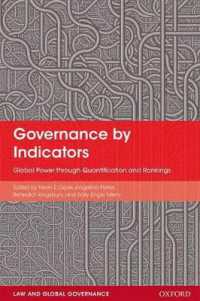- ホーム
- > 洋書
- > 英文書
- > History / World
Full Description
Every day millions of people enter public buildings of many forms and functions: Notre-Dame in Paris, Central Station in New York; the British Museum in London, that are decorated with recessed doorways. None of them is likely to be aware that this style of decoration has been continuously employed for 6500 years in temples, royal palaces, tombs, churches, synagogues and modern public buildings, becoming a symbol of the divine and of a place of worship. During this very long period, from the ancient Near East until today, the world has undergone immense changes, but the concept of the recessed opening was never forgotten or abandoned. What is the secret of its longevity? This unique cultural edifice is not only about architecture, but is a language that defines social order and relations with the ruling power and authorities. These, sometimes highly decorated and elaborate, sometimes simple and understated, thresholds in fact functioned on two communicative levels: first, as a liminal marker demarcating a sacred area and second, to emphasize the social order, as few were permitted to pass through. In this book the history of this eternal symbol is presented for the first time through text, figures and photographs. The authors consider historical, anthropological, sociological, religious and economic factors that reflect the significance of crossing these iconic thresholds according to the concept of the longue durée.
Contents
Foreword
Acknowledgements
List of Figures and Tables
Part I. Introduction, Methodology, Summarizing the Data, Discussion
Chapter 1: Introduction
Chapter 2: Methodology
Chapter 3: Summarizing the Data
Chapter 4: Discussion
Part II. The Data: Recessed Openings in Architecture, Iconography and Text
Chapter 5: Recessed Openings from Late Prehistoric Mesopotamia (fifth and fourth millennia BCE)
Chapter 6: Recessed Openings of the World's Earliest Cities (late fourth and third millennia BCE Mesopotamia)
Chapter 7: Recessed Openings in Second Millennium BCE Mesopotamia and Adjacent Regions
Chapter 8: Recessed Openings in First Millennium BCE Mesopotamia
Chapter 9: Recessed Openings in the Iron Age and Persian Period in the Levant, Sardinia and Carthage (10th to 4th centuries BCE)
Chapter 10: Recessed Openings in Late Antiquity Judaism
Chapter 11: Recessed Openings in the Greek, Hellenistic and Roman Worlds (sixth century BCE to third century CE)
Chapter 12: Recessed Openings in Early Christian Architecture: Byzantine, Romanesque and Gothic (fourth century to 13th century CE)
Chapter 13: Recessed Openings in later Periods
References








